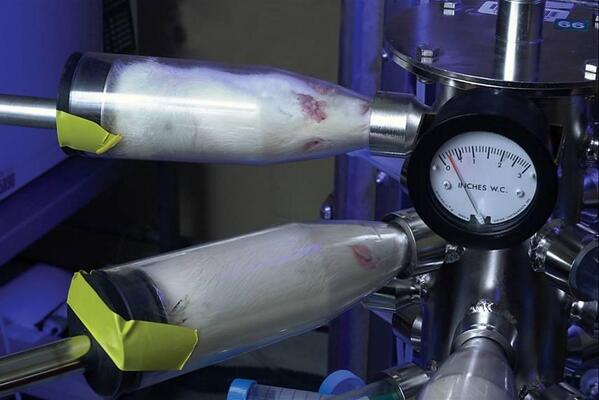Ethical and scientific considerations are driving a move away from animal testing.
By George Gay
When I wrote asking for contributions to this story about replacing nonhuman animals in laboratory respiratory testing, one respondent replied that, unfortunately, this was outside his area of expertise, though not outside his area of interest. He went on to suggest that we replace the nonhuman animals with politicians before adding, in the words of the very wise W.S. Gilbert, “they’ll none of ’em be missed, they’ll none of ’em be missed.”
It will come as no surprise that the person in question is based in the U.K. and that his comment can be seen as trying to lighten the pain caused by that country’s three years of political shenanigans over Brexit, though, as Louis MacNeice speculated about another matter, it is a moot point whether something so corrupted can be cured by laughter. But the comment was useful because it brought to mind the term “political animal” and reminded me that we are all animals, or, as William McIlvanney once said, “We are part animal. Humanity is an aspiration, not a fact of everyday life.”
Regrettably, it would seem, this aspiration can hardly be said to have blossomed, at least within the tobacco and nicotine spheres, even though the weather is set fair, or perhaps it would be fairer to say that it has not been allowed to blossom. Amy Clippinger, president of the PETA International Science Consortium, told me during an email exchange in August that testing tobacco products on animals was banned in Belgium, Estonia, Germany, Slovakia and the U.K. on the grounds—unarguable in my view—that it was unethical to subject animals to testing products that are inherently unsafe for humans.
This is all well and good, but it also suggests that something like 190 countries don’t ban such practices when, as Clippinger said, “We know that it is immediately achievable for all regulatory agencies to ban tests on animals for smoke and e-vapors—and all countries should follow suit.”
This story arose out of an August press note from PETA that described how the Science Consortium, which works to accelerate the development, validation and global implementation of animal-free testing, had, together with Altria, British American Tobacco, Imperial Brands and Philip Morris International, donated equipment that could help to replace the use of animals in respiratory testing with more human-relevant, non-animal test methods.
“The equipment—worth $110,000 and manufactured by Germany-based Vitrocell Systems—was donated to the Institute for In Vitro Sciences (IIVS), a nonprofit laboratory in Gaithersburg [Maryland, USA,] that conducts animal-free testing,” the press note said. “It will be used in the IIVS in vitro respiratory toxicology laboratory, which helps companies assess the effects of tobacco, nicotine and other aerosols on the human respiratory tract. Results from these tests will also help to show regulatory agencies, such as the U.S. Food and Drug Administration, that non-animal methods are accurate and effective and can be used instead of tests on animals.”
That regulatory bodies still need convincing seems odd given that this is the 21st century and given what Clippinger had to say: “It often takes time to make changes to existing regulations but there is overwhelming scientific evidence that supports the use of animal-free testing approaches.”
A different animal
“We know that animal tests aren’t good predictors of human results—for example, negative results in animal studies were used for years to suggest that cigarettes don’t cause cancer,” she said in what appeared to me to be an incontrovertible repudiation of the value of animal testing—at the very least in this area. “It is well-established that differences in anatomy and physiology between the rodent and human respiratory tract limit the precision with which the rodent test predicts the human response.”
For example, Clippinger said there were differences in the ventilation rates and breathing modes between humans and animals. Humans breathed through their noses and mouths while rodents breathed only through their noses, a difference that affected particle and gas deposition.
“Anatomically, there are differences in the airway architecture and branching pattern of the respiratory tract,” Clippinger said. “The branching pattern in rodents is asymmetric or monopodial, which results in a relatively unimpeded airflow whereas the branching pattern in humans is bi- or tripodial, resulting in an airway pattern more susceptible to deposition at its bifurcation points.
“There are also species differences in the cell types and their distribution within different regions of the respiratory tract, mucous composition and metabolic activity of critical enzymes.
“All of these differences affect the deposition of an inhaled agent as well as its clearance or retention. Therefore, there has been significant interest in developing human cell-based approaches that can characterize the toxicity of inhaled substances while also providing a better understanding of how an inhaled material exerts its toxic effects in humans. We know there are more human-relevant and humane animal-free methods, and, sooner or later, regulations will catch up to the science.”
Catching up
Sooner, in my view, would be just fine—later, not so because from what is said above it would seem that all that is stopping the transition away from animal testing is inertia on the part of regulators, and there is no excuse for inertia in circumstances where countless nonhuman animals are being abused for no apparent reason. We know already that smoking is life-threatening, and common sense should tell us that vaping, though much less risky than smoking, is not going to be risk-free.
The question arises, therefore, as to how long such a transition might take, and Clippinger indicated that the process would depend on whether the animal testing regimes in place were a matter of regulatory requirement or a nonrequired test. “In general, changing regulatory requirements for animal tests often involves a multi-pronged approach that includes having suitable alternative methods,” she said. “In the field of respiratory toxicology, for example, those methods include human cell lines and three-dimensional models. In fact, the Science Consortium funded the development of one such model and partnered with a biotech company to give away three-dimensional tissue models to researchers for free. Laboratories must also have the infrastructure needed to conduct these tests, which is why we donated the Vitrocell equipment. The remaining steps are for researchers and regulatory agencies to understand which non-animal assays are appropriate to use in specific testing situations and to gain confidence that the non-animal methods can protect human health as well as or better than the animal tests. The ongoing testing that we are funding and the educational opportunities that we provide will help overcome this hurdle.
“It can take time for regulations to catch up with science—and often needs PETA to champion the transition. But we’re seeing signs of the replacement of animals in toxicity tests and know it is a matter of when, not if, these animal tests are eliminated altogether. The Dutch government plans to phase out many types of animal testing by 2025, and, in the United States, the Environmental Protection Agency is making strides as well. Companies are publishing on their work to advance animal-free testing approaches and proactively submitting data from non-animal tests to the United States Center for Tobacco Products to register their products. Because animals are often poor predictors of the human response, there are scientific and ethical factors driving the transition to animal-free testing.”
The donations of Vitrocell in vitro equipment came about because the Science Consortium wanted to be sure that companies interested in transitioning to in vitro inhalation testing had facilities they could go to for this testing, and it had heard that there were few contract research organizations providing such services. Four of the Science Consortium donations of Vitrocell equipment were made during 2017 to facilities in Belgium, the U.K. and the U.S. while, in 2019, it recognized the need for two donations to provide additional equipment at IIVS. So this year, the Science Consortium donated a $50,000 Vitrocell Cloud device that can be used for testing personal care products, for example, but not tobacco products. And then, in order to spread the costs of the second donation, it approached the four tobacco companies known to be interested in advancing non-animal testing methods, and they contributed $20,000 each with the Science Consortium putting in $10,000.
Vitrocell Systems describes itself as one of the pioneers of in vitro exposure systems with 20 years of experience in providing test systems in which cultivated cells from the respiratory tract or bacteria are exposed to aerosols.
Managing Director Tobias Krebs told me that the company had significantly broadened its range of turnkey systems comprising smoking machines, exposure systems, dosimetry tools and analytical instruments. Demand for these advanced systems was creating constant growth, he said, due to two factors, one of which was the increased testing needs of industry, research institutes and regulatory bodies as new products were developed by the industry in ever shorter cycles. There was a need for electronic nicotine-delivery systems, heated-tobacco products and hybrid devices to be compared with traditional combustible products in respect of their toxicological profiles.
At the same time, there was a clear trend for the industry and regulators to seek alternatives to animal testing. The acceptance of alternative methods had increased during recent years with the goals of sacrificing fewer animals, of obtaining reliable results faster and of reducing costs.








